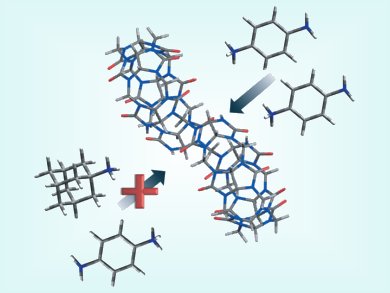Lyle Isaacs, University of Maryland, USA, has prepared a ditopic receptor molecule belonging to the cucurbituril family. This molecular container, nor-seco-cucurbit[10]uril, binds two guest molecules of similar size and shape to form ternary complexes. Electrospray ionization is used to transfer the intact supramolecular assemblies from their acidic solution to the gas phase.
A consortium of three groups investigated the binding properties of this molecular container and obtained a full description of the tenary complexes at a molecular level. Experimental data was obtained using mass spectrometry by the group of Pascal Gerbaux, University of Mons, Belgium. The gas-phase structures of the complexes were elucidated by means of ion-mobility spectroscopy and computational chemistry by the teams of Philippe Dugourd, University of Lyon, France, and Jérôme Cornil, University of Mons, respectively.
According to the researchers “All experimental and theoretical data point to the conservation of the condensed phase structure upon desolvation and transfer to the gas phase. Carefully driven competition reactions in solution demonstrated unambiguously the size selectivity of the receptor, that is, the binding of the first guest determines the size and shape of the second encapsulated molecule”.
- Homotropic Allosterism: In-Depth Structural Analysis of the Gas-Phase Noncovalent Complexes Associating a Double-Cavity Cucurbit[n]uril-Type Host and Size-Selected Protonated Amino Compounds
Vincent Lemaur, Glenn Carroy, Frédéric Poussigue, Fabien Chirot, Julien De Winter, Lyle Isaacs, Philippe Dugourd, Jérôme Cornil, Pascal Gerbaux,
ChemPlusChem 2013.
DOI: 10.1002/cplu.201300208




